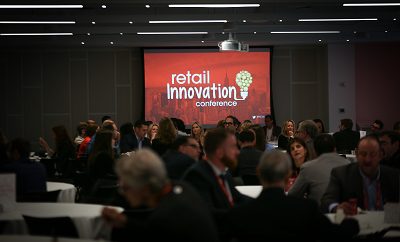The 2018 Retail Innovation Conference featured more than 50 retail industry executives and experts speaking on a wide range of the hot topics — from the sometimes-difficult move from online to brick-and-mortar to optimal use cases for AI, voice and personalization. These 17 quick quotes provide a “tasting menu” for those that couldn’t make the conference, which was held April 30-May 2 in New York City.
“If you want the rewards of creativity and innovation, you have to take the risk. Comfort zones are great, but nothing actually grows there. They’re deserts.” — Ken Hughes, Award-Winning Shopper Behaviouralist
Creativity can’t be cultivated by simply creating the right environment — you have to work personally to generate fresh ideas and innovations. Trendy accoutrements like beanbag chairs or coffee bars are what Hughes calls “lipstick on a gorilla” — they’re superficially attractive, but don’t actually improve the creative process, which is ultimately a personal responsibility.
“Voice-activated technology will be a significant disruptor and consumers will expect retailers to have proficiency with it.” — Michael Colaneri, VP, AT&T Global Business-Enterprise Solutions
There are several technologies with “varying degrees of readiness” to disrupt retailing in its current form, Colaneri said, but the most significant and immediate one is voice activation. “Within 24 months, 20% of e-Commerce is expected to be voice-activated,” he noted. Other technologies that will have an impact include AI, VR and robotics.
Advertisement
“Imagine if you could have more stores in December and fewer stores in June.” — Traci Inglis, Brand President, TechStyle Fashion Group
Inglis noted that it can cost $250,000 to open a store, the traditional way that retailers have added customers. But TechStyle’s use of digital advertising for customer acquisition allows the retailer to be more agile and strategic with its spend.
“I think that in some ways Amazon has been a big positive in retail in that it’s helped to cull the herd. I remember seeing reports 20 years ago that there were too many retail stores out there. If we were overstored 20 years ago, we’re more overstored now.” — Brian Nagel, Managing Director & Senior Retail Analyst, Oppenheimer & Co.
The Wall Street analyst took a somewhat contrarian view of the role of the e-Commerce giant, noting that its commitment to innovation and customer focus has helped the overall industry by forcing poorly managed retailers out of the competitive landscape.
“No, we don’t have e-Commerce, and that’s not the way our customers like to interact with us. That’s not the way these hot deals that are here today, gone tomorrow lend themselves to the customer.” — Erin Estelle, Marketing Director, 99 Cents Only Stores
Not all retailers need to go digital immediately. Price-based consumers aren’t digitally engaged, and so 99 Cents Only Stores hasn’t invested in an e-Commerce front it doesn’t need. However, the company doesn’t ignore the capabilities of mobile: it still engages with customers digitally to reach them with its creative message.
“In my business, people think about going in and buying a brand-new smartphone as the equivalent of getting a root canal.” — Michael Moore, Chief Experience Officer, Victra
Victra is making the shopper journey as pleasant as possible and is taking a page from Alfred Hitchcock’s dual script concept: a “blue script” detailing the physical elements, and a “green script” about the desired emotional experience. Victra spends 20% of its effort on the blue script, and the remaining 80% on the green script, with a focus on bringing solutions together in a way that reflects how shoppers use their devices.
“We like to imagine the future of retail without imagining how it’s different for different customers, and there are different needs for different customers.” — Kasey Lobaugh, Chief Innovation Officer, Deloitte
Retail executives and their peers are generally on the upper end of the income scale, which isolates them from the needs of shoppers in other demographics. The Great Retail Bifurcation found that the retail apocalypse was a myth, but that the market is splitting between high-end and value chains. Price-focused retailers saw 37% growth over a five-year period, while premier retailers grew 80% and balanced retailers recorded a sluggish 2% growth rate.
“The challenge for a lot of retailers is they end up straddling the middle and end up not really good at anything, or they try to out-Amazon Amazon, and I think that is a very dangerous strategy for almost everyone.” — Steven Dennis, President of SageBerry Consulting
Physical retailers should focus on one of two directions to prevent from entering the abyss of “boring” retailers that became obsolete. retailers can pivot toward convenience, great price or a vast assortment, or focus on building experience-focused stores. Dennis noted that the inability to choose a side prevents any brick-and-mortar brand from standing out and becoming remarkable in the eyes of the shopper.
As technology evolves, “our company journey has been our customer’s journey.” — Chris McCann, CEO, 1-800-Flowers.com
1-800-Flowers revolutionized the floral industry with the then-new technology of toll-free phone numbers. The company moved online early, selling products on AOL in 1994, and embraced mobile more than 10 years ago. 1-800-Flowers is now mobile-first, McCann said, but it is becoming AI-first. Two years ago, the company launched a bot on Facebook Messenger, a voice-activated skill on Amazon’s Alexa platform and GWYN (Gifts When You Need), a proprietary virtual concierge powered by IBM Watson. What’s next? McCann has a team investigating robotics.
“We had very fast growth online, but no clue of the constraints of the physical world.” — Romain Liot, COO, Adore Me
Adore Me, an e-Commerce retailer of fine lingerie founded in 2010, has enjoyed phenomenal growth, increasing revenue by almost 1,400% from 2014 to 2016, according to the most recent Inc. 5000 list of the fastest-growing private companies. “Then we said, ‘What about offline? Can we crack that?’” Liot recalled. After building a $10 million warehouse and distribution center from scratch last year, Adore Me is preparing for the next phase of its evolution, opening 200 or more stores in five years. Its first boutique will debut in Staten Island, NY in June.
“It might seem fun and exciting for a new brand to come in and disrupt an industry, but we didn’t want to do that.” — Eugene Alletto, Quarterback/Founder and CEO of BEDGEAR
In 2009, Alletto set out to wake up the “boring” bedding business with his vision for a new category of technology-based sleep solutions that addressed not just mattresses but also pillows, sheets, blankets, mattress protectors and more. Rather than compete with existing stores, BEDGEAR partnered with them to be “additive, not disruptive” with breakthrough products and merchandising. With BEDGEAR now available at retailers in 41 countries, Alletto believes his company can improve sleep around the world, which will make people feel better and lead to no less than “world peace.”
“I like to think of machine learning/AI as the right solution for when you want to do something that is possible to do on your own, but it would just take you a dozen analysts and a week to do. But when you need to make those decisions in a millisecond you have to rely on a machine learning model.” — Nariman Noursalehi, VP of Marketing, Customer Acquisition, Overstock.com
Overstock uses machine learning in three areas: merchandising is “probably the easiest area,” said Noursalehi. “You’re forecasting on a SKU-by-SKU level. We have 6 billion SKUs on our site. There’s no way human beings can know the forecasting on all of those.” Marketing and web site personalization present other strong use cases for machine learning.
“If we can’t agree on what personalization is, and what the steps are that are required, then who is going to give you the millions of dollars and people you need to achieve that?” — Jared Blank, SVP, Marketing and Data Insights, Bluecore
While the BCG 2016 Global Personalization Survey revealed that the top organizational barrier to personalization is that too few personnel are dedicated to personalization, Blank said that the second-largest organizational banner — a lack of a clear roadmap — is more detrimental to a retailer’s personalization strategy. “Developing a roadmap requires a whole bunch of steps, and those steps require steps,” he noted.
“Encourage Nemawashi.” — Fareena Contractor, Senior Technology and Innovation Leader, Walmart Canada
Nemawashi is a Japanese term meaning “laying the roots” for the next big idea. Contractor referred to a conversation with a coworker who always had positive interactions with everyone in the room and often got the business results he desired. His secret sauce? Always going out of his way to share the foundation of a proposed project by talking to those concerned to gather support and feedback. “He’s having these conversations with different people that are going to be decision makers in getting their buy-in early,” said Contractor. “He’s working smarter, not harder.”
“Sleep is an experience. We want to meet the consumer where and how they shop, experience and gather information.” — Angela Gearhart, VP of Brand Experience, Sleep Number
Sleep Number uses experiential storytelling to extend the brand beyond the store to drive demand with digital at the core. Retail is everywhere for Sleep Number; it’s where the customer wants to connect with you. For the company, it’s online, in its 600 stores and in almost 5,000 events throughout the year, which include the Super Bowl. The company offers proprietary sleep experiences and innovations including the 360 Smart Bed, exclusive distribution (the company owns all of its channels) and lifelong customer relationships through its SleepIQ technology.
“The importance of product design can’t be understated. We think of packaging as a canvas to connect with customers; a way to tell a story.” — Jeff Gamsey, VP of Private Brands, Boxed.com
When launching the company’s private label brand, Prince & Spring, BOXED had one goal: to do private brand in the grocery world better than it had been done before, and to use it to build an emotional connection with customers. A key focus for the line was the look of the packaging; the company does all design in-house.
“If you can’t deliver on price and/or convenience, deliver on experience. The key is to communicate that with customers so they understand what you’re doing for them.” — Lisa van Kesteren, CEO and Founder, SeeLevel HX
SeeLevel HX conducted a mystery shopping study in New York City, focusing on the customer experience. The top-ranking retailers included Sunglass Hut, Tiffany & Co., Bloomingdale’s, Adidas, Sephora, Rebecca Minkoff, Superdry and La Maison Du Chocolat, for unique in-store technologies, outstanding customer service and more.
Retail TouchPoints will be providing more coverage of the event in coming days. Our coverage so far includes: #RIC18: Unlocking The Secrets Of Gen Z Shoppers
#RIC18: Walmart CIO Embraces People-Led, Tech-Powered Strategy















